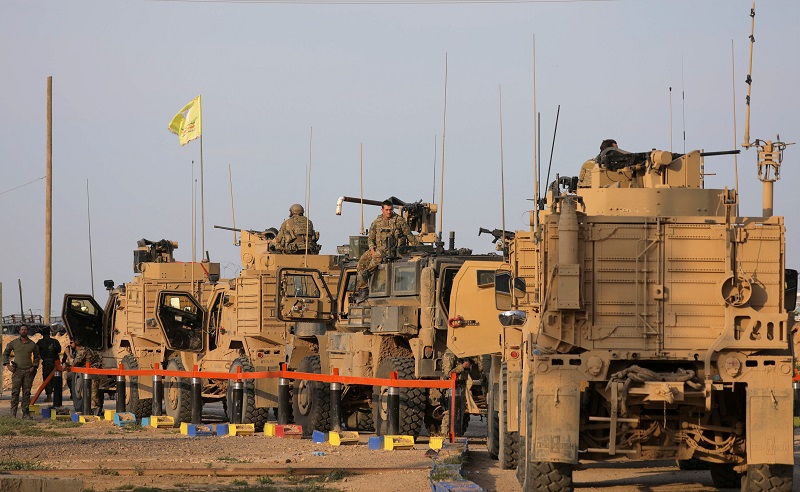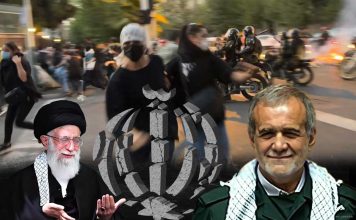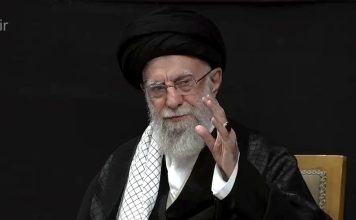AMMAN, Aug 26 (Reuters) – Deadly skirmishes have been on the rise in recent days between U.S. forces and Iran-aligned militias in Syria’s oil-rich east, where both have carved out strategic footholds. Read full story
Here is a closer look at their rival zones of influence in the desert province of Deir al-Zor, where rocket, mortar and drone attacks have increased – just as negotiations over the revival of a nuclear deal between Iran and the West come to a head. Read full story
[aesop_image img=”https://kayhanlife.com/wp-content/uploads/2022/08/2019-03-23T154340Z_1011101743_RC168E86AEF0_RTRMADP_3_MIDEAST-CRISIS-ISLAMIC-STATE-SDF.jpg” panorama=”off” credit=”REUTERS/Rodi Said” align=”center” lightbox=”off” captionsrc=”custom” caption=”FILE PHOTO/American soldiers stand near military trucks, at al-Omar oil field in Deir Al Zor, Syria March 23, 2019. ” captionposition=”left” revealfx=”off” overlay_revealfx=”off”]
A PROVINCE DIVIDED
Syria’s eastern Deir al-Zor is a 33,000 square kilometre (12, 741.37 square mile) desert province, divided diagonally by the Euphrates River and mostly populated by tribes that share kinship with neighbouring Iraq.
Syria’s government and its backers on one side, and the United States and its Syrian allies on the other, fought separately to oust Islamic State fighters from the zone.
Now, the U.S. forces and their allies on the ground – the Kurdish-dominated Syrian Democratic Forces – are based in two large oil and gas fields in the province’s eastern half.
The fields – locally known as Al Omar and Conoco – host most of the 900 U.S. servicemen deployed in Syria.
The provincial capital of Deir al-Zor, the strategic border town of Albu Kamal and the area south and west of the river are held by Syria’s government and allied fighters, with the Iranian units among them seen as the most elite.
These fighters have also taken up bases on a collection of river islands known as Hweija Sakr, which they use as a launching pad for attacks on U.S. forces across the river.
FIVE YEARS OF TENSIONS
The United States says its presence there aims to ensure the lasting defeat of IS, but skirmishes with Iran-backed groups have sporadically broken out over the last five years.
In the first attack in June 2017, a suspected Iranian drone targeted the outskirts of the Tanf garrison, a U.S. outpost at the intersection of Syria’s borders with both Iraq and Jordan.
U.S. warplanes responded with strikes against Shi’ite militias closing in on the base.
Since then, Iran-aligned groups have fired mortars, Iranian-manufactured rockets, and small unmanned drones at Tanf and the oil and gas fields.
The U.S.-led coalition has responded with air strikes by jets and helicopters, typically targeting weapons depots or other infrastructure.
In some cases, the United States has responded to rocket attacks on its troops in neighbouring Iraq by bombing positions along the Syrian-Iraqi border hosting Iraqi armed groups tied to Iran.
EXPANDING IRANIAN INFLUENCE
Alongside Russia, Iran and its proxies have been instrumental in helping Syrian President Bashar al-Assad regain most of the territory his forces lost since conflict erupted in 2011.
That has allowed them to retain and build up their zones of influence in far-flung parts of the country even after battles have subsided: from the northern city of Aleppo, recaptured by government-aligned forces in late 2016, to the vast desert zones in Homs and Hama and the suburbs of the capital Damascus.
In particular, Iran has extended support in energy and mineral exploitation to Syria, helping rehabilitate power plants and extract phosphate.
Its troops and their allies retain effective control of Syria’s eastern front with Iraq, where units from Iran‘s elite Quds Force are suspected to be based, and its western border with Lebanon.
That corridor allows Tehran to transfer people, goods and military equipment across several countries – prompting serious concern in Israel, which has carried out its own air attacks against Iranian forces and their allies in Syria.
(Reporting by Suleiman Al-Khalidi; Editing by Maya Gebeily and Tomasz Janowski)








